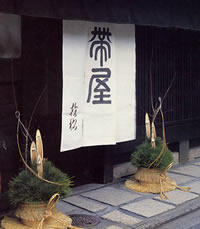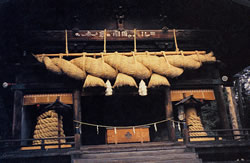 |
 |
kadomatsu |
shimenawa |
On Omisoka (31 December) the striking of the joya no kane (end-of-the-year) bell is performed in Buddhist temples in Japan in a ritual meant to dispel the evils of the previous year. During this ceremony—which draws people to the temple and to the local Shinto shrines—the bell is sounded 108 times, each toll struck after the reverberations from the preceding one have dissipated and timed so that the last is struck at midnight. Ganjitsu is the auspicious first day of Shogatsu, the first month of the Japanese year, a day on which many people strive to be up in time to greet the rising sun. The New Year celebrations last for three days (1-3 January), a period when people pray for good health and fortune.
Kadomatsu are placed at the entrance of houses in the days leading up to New Year. Comprised of pine boughs (symbolising longevity), bamboo stalks (prosperity) and plum-tree sprigs (constancy), they are set up as an invitation to the god of the year—the toshigami, protector of household prosperity—to come in and bless the home.
Sacred places in Japan are typically marked by a shimenawa—a specially plaited rope (nawa) festooned with strips of white paper (shime) symbolising purity—which are meant to keep away evil spirits. During Ganjitsu, shimenawa are often hung on the doors of homes and businesses as well. On the seventh day of the year (or fifteenth, depending on the area) the kadomatsu and shimenawa are burned, the flames intended to act as a beacon to send the god of the year on his way.
Ancestral shrines in the home are decorated with kagamimochi, two large cakes of glutinous rice (mochi) offered to the Buddha and other deities. The round shape of the rice cakes symbolises fulfillment in the family, and having them in a stack indicates the successful “piling up” of another year to one’s life.
An essential part of the New Year meal is ozoni, a soup made with mochi. The custom of eating ozoni at New Year started in the 15th century when people took mochi that had been offered to the toshigami and simmered them in fresh water over a new flame; the addition of food from the sea and the mountains made a dish thought to provide power for the coming year. The word ozoni means “mixed simmering,” a reflection of the contents, the choice of ingredients being a matter of regional differences and family preference.